TOYOTA LAND CRUISER 2015 J200 Owners Manual
Manufacturer: TOYOTA, Model Year: 2015, Model line: LAND CRUISER, Model: TOYOTA LAND CRUISER 2015 J200Pages: 728, PDF Size: 10.53 MB
Page 111 of 728
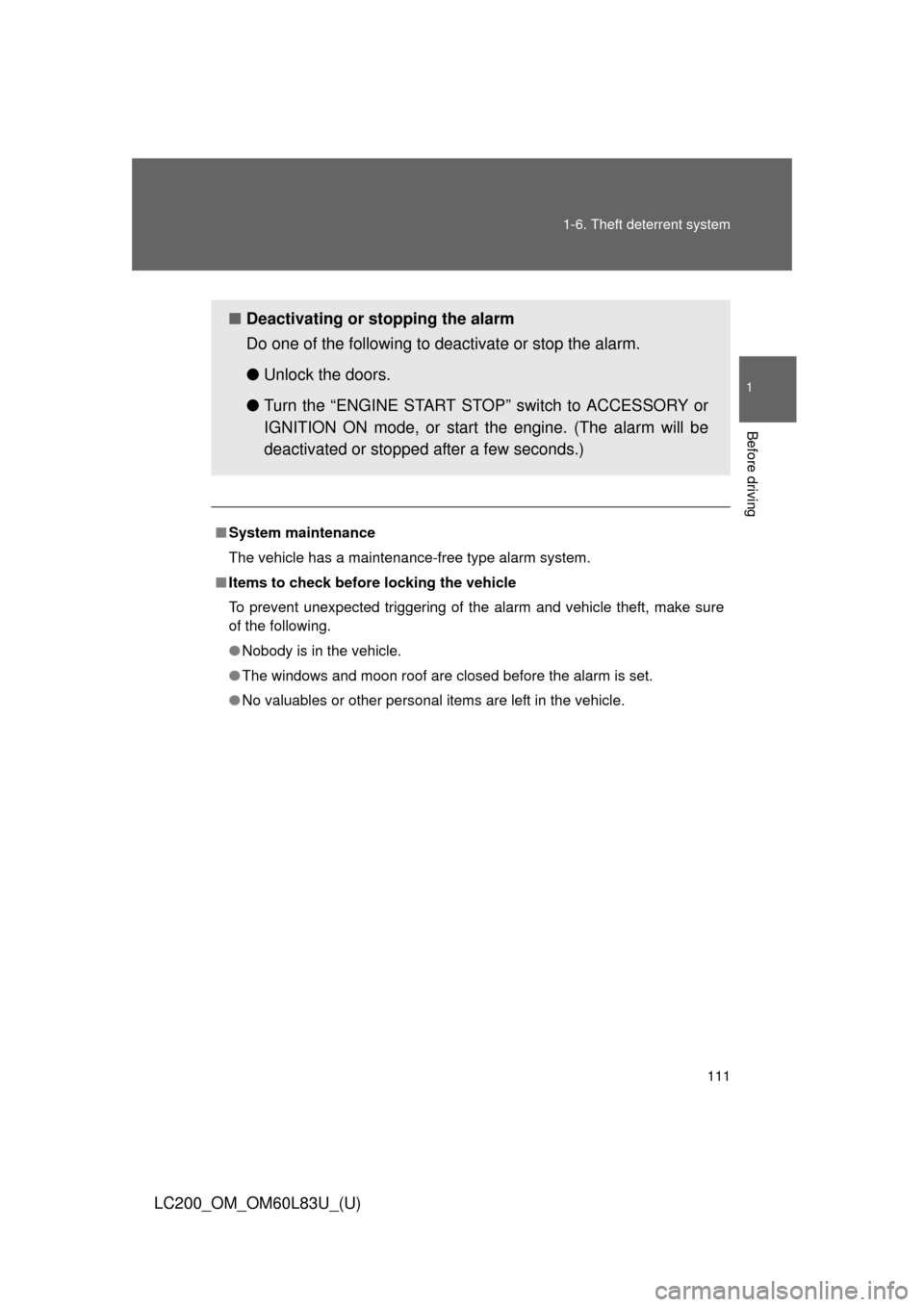
111
1-6. Theft deterrent system
1
Before driving
LC200_OM_OM60L83U_(U)
■
System maintenance
The vehicle has a maintenance-free type alarm system.
■ Items to check before locking the vehicle
To prevent unexpected triggering of the alarm and vehicle theft, make sure
of the following.
●Nobody is in the vehicle.
● The windows and moon roof are closed before the alarm is set.
● No valuables or other personal items are left in the vehicle.
■ Deactivating or stopping the alarm
Do one of the following to deactivate or stop the alarm.
●Unlock the doors.
● Turn the “ENGINE START STOP” switch to ACCESSORY or
IGNITION ON mode, or start the engine. (The alarm will be
deactivated or stopped after a few seconds.)
Page 112 of 728
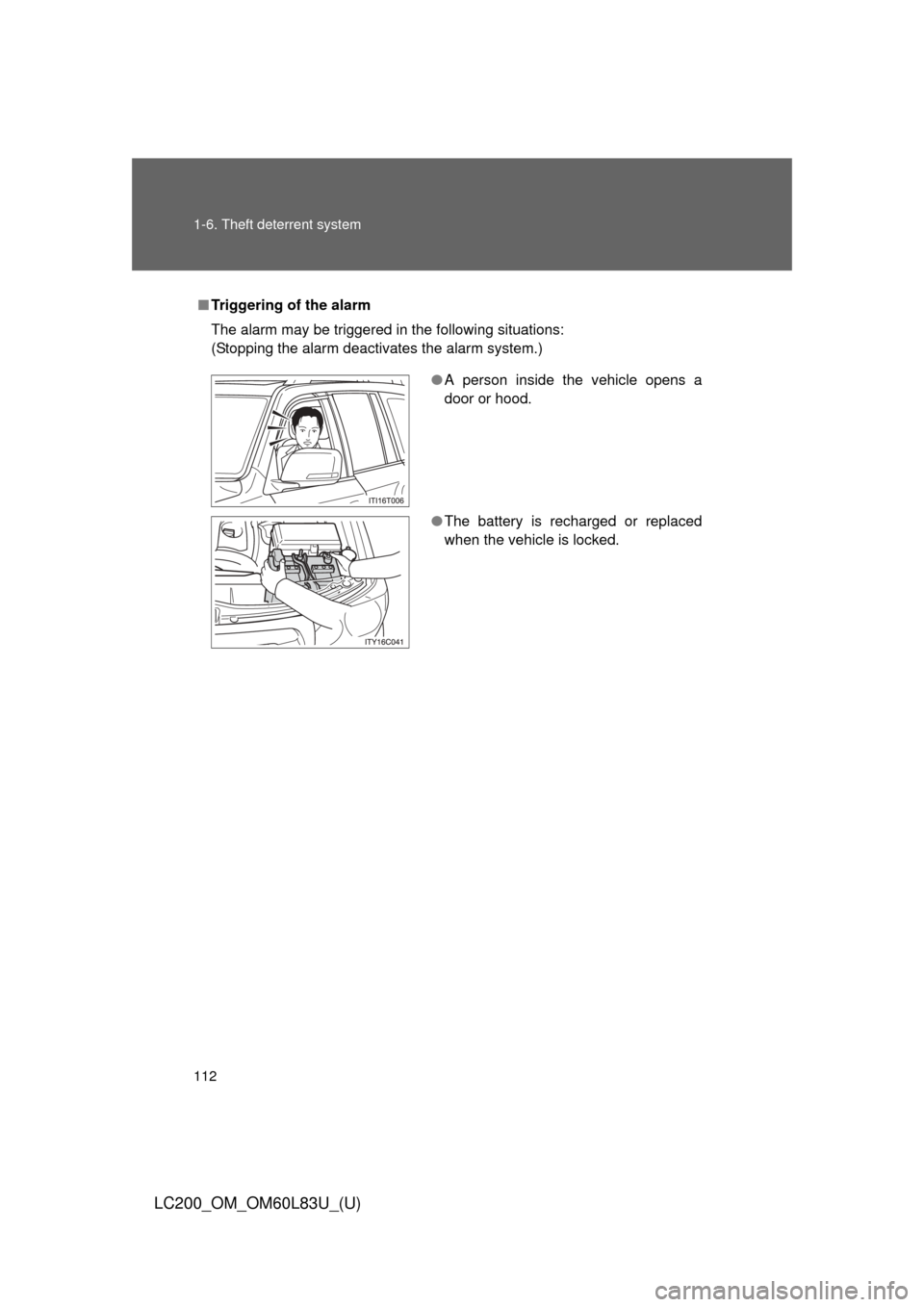
112 1-6. Theft deterrent system
LC200_OM_OM60L83U_(U)
■Triggering of the alarm
The alarm may be triggered in the following situations:
(Stopping the alarm deactivates the alarm system.)
●A person inside the vehicle opens a
door or hood.
● The battery is recharged or replaced
when the vehicle is locked.
Page 113 of 728
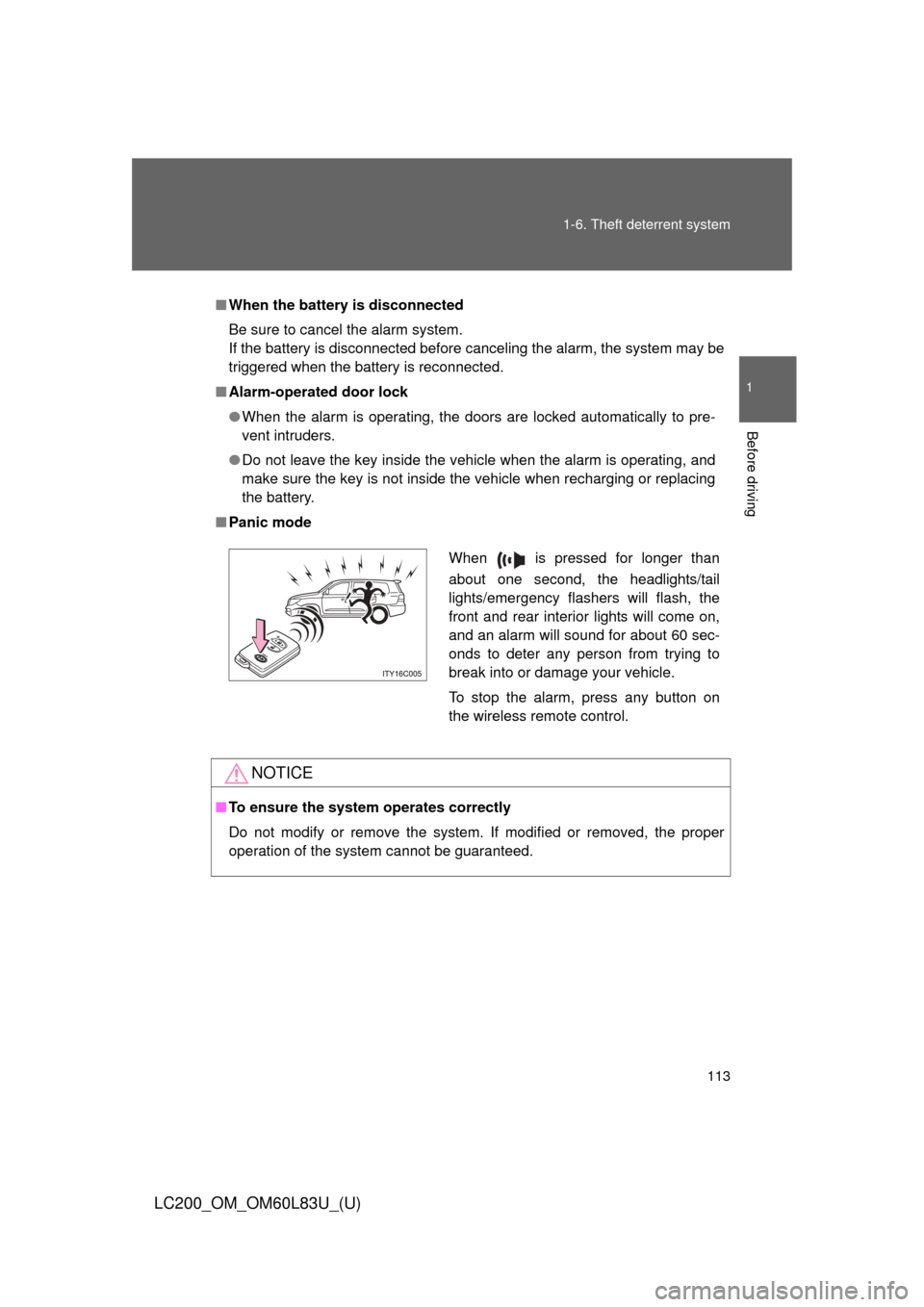
113
1-6. Theft deterrent system
1
Before driving
LC200_OM_OM60L83U_(U)
■
When the battery is disconnected
Be sure to cancel the alarm system.
If the battery is disconnected before canceling the alarm, the system may be
triggered when the battery is reconnected.
■ Alarm-operated door lock
●When the alarm is operating, the doors are locked automatically to pre-
vent intruders.
● Do not leave the key inside the vehicle when the alarm is operating, and
make sure the key is not inside the vehicle when recharging or replacing
the battery.
■ Panic mode
NOTICE
■To ensure the system operates correctly
Do not modify or remove the system. If modified or removed, the proper
operation of the system cannot be guaranteed.
When is pressed for longer than
about one second, the headlights/tail
lights/emergency flashers will flash, the
front and rear interior lights will come on,
and an alarm will sound for about 60 sec-
onds to deter any person from trying to
break into or damage your vehicle.
To stop the alarm, press any button on
the wireless remote control.
Page 114 of 728
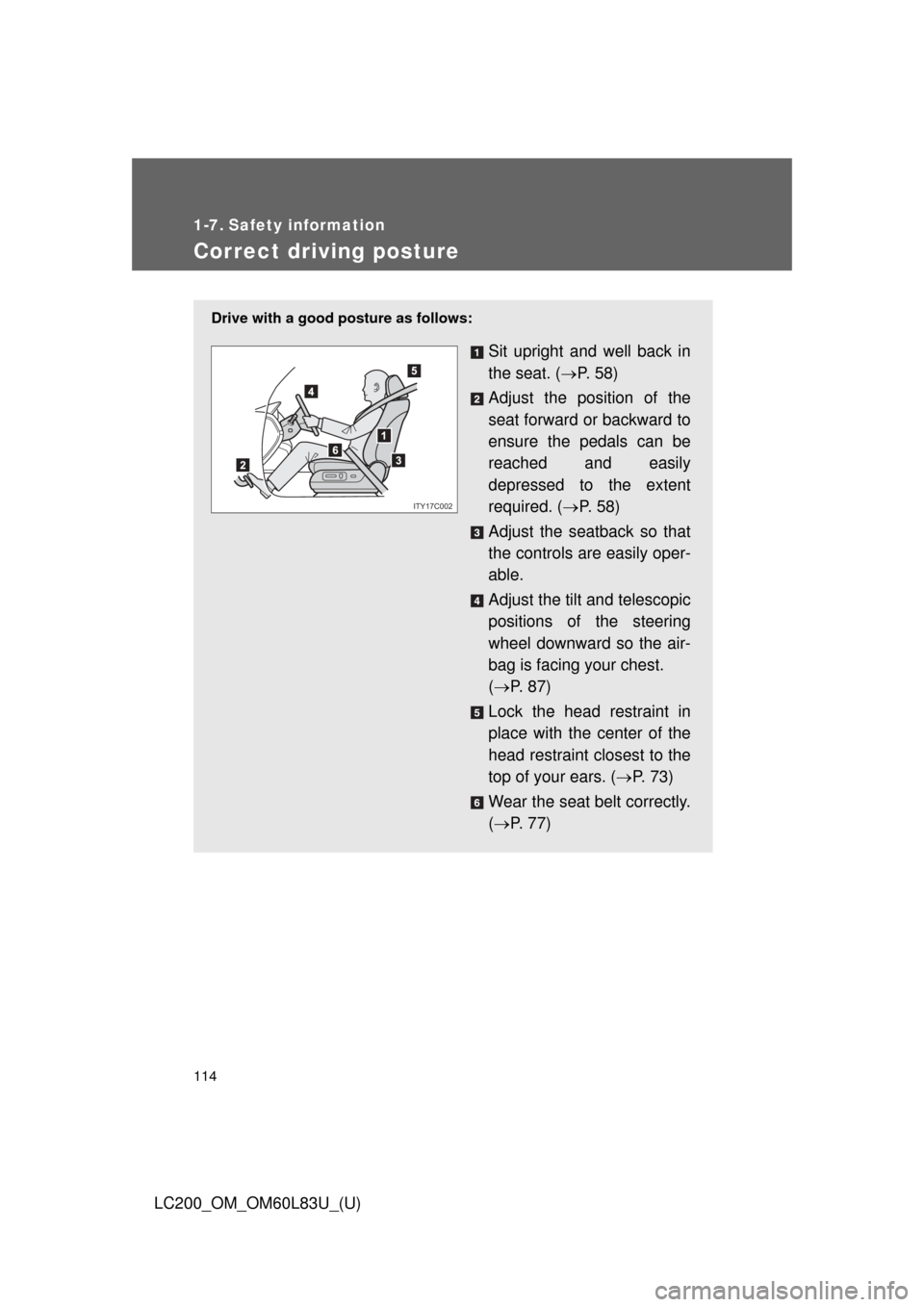
114
LC200_OM_OM60L83U_(U)
1-7. Safety information
Correct driving posture
Drive with a good posture as follows:
Sit upright and well back in
the seat. (P. 5 8 )
Adjust the position of the
seat forward or backward to
ensure the pedals can be
reached and easily
depressed to the extent
required. ( P. 58)
Adjust the seatback so that
the controls are easily oper-
able.
Adjust the tilt and telescopic
positions of the steering
wheel downward so the air-
bag is facing your chest.
( P. 87)
Lock the head restraint in
place with the center of the
head restraint closest to the
top of your ears. ( P. 73)
Wear the seat belt correctly.
( P. 77)
ITY17C002
Page 115 of 728
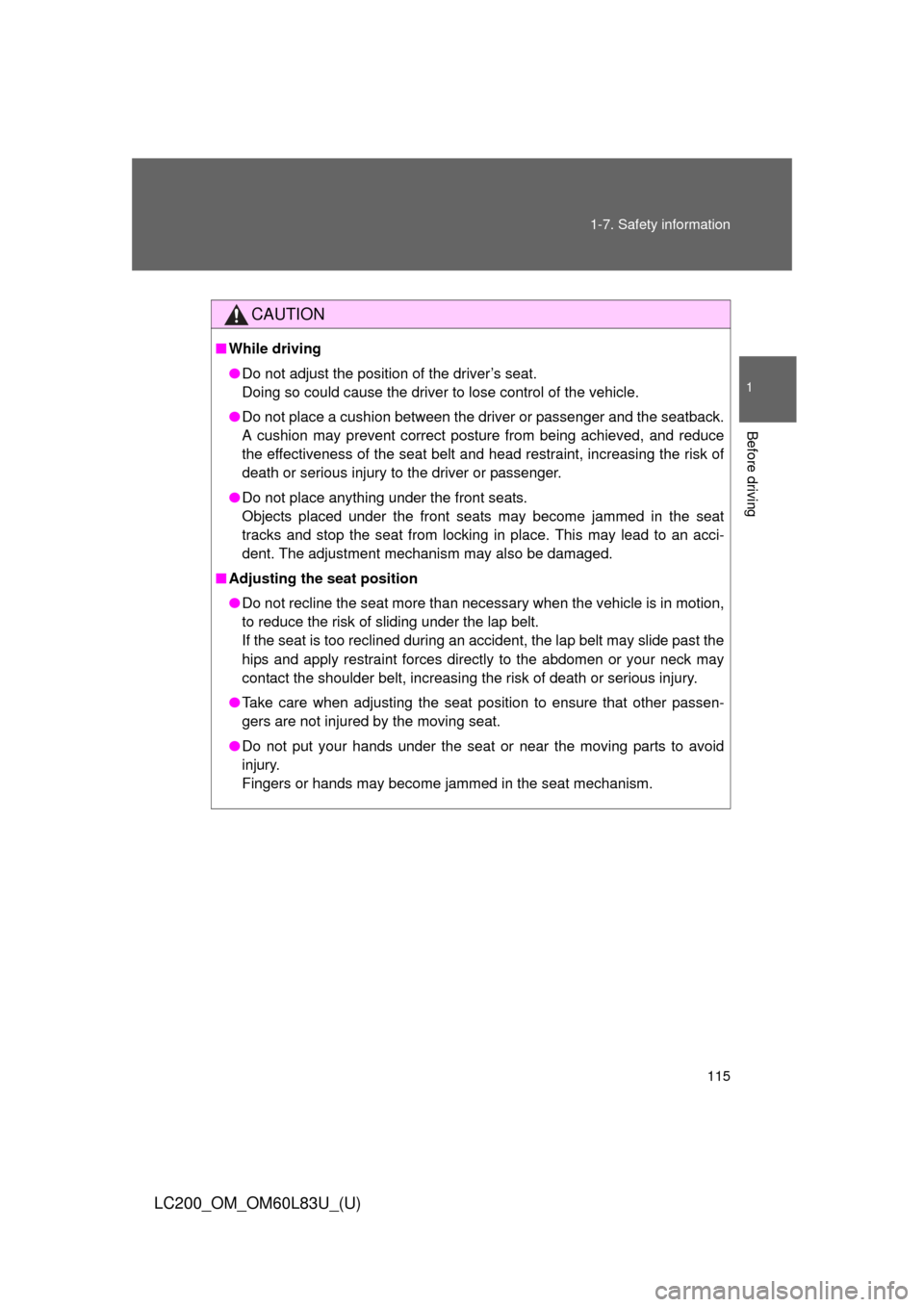
115
1-7. Safety information
1
Before driving
LC200_OM_OM60L83U_(U)
CAUTION
■
While driving
●Do not adjust the position of the driver’s seat.
Doing so could cause the driver to lose control of the vehicle.
● Do not place a cushion between the driver or passenger and the seatback.
A cushion may prevent correct posture from being achieved, and reduce
the effectiveness of the seat belt and head restraint, increasing the risk of
death or serious injury to the driver or passenger.
● Do not place anything under the front seats.
Objects placed under the front seats may become jammed in the seat
tracks and stop the seat from locking in place. This may lead to an acci-
dent. The adjustment mechanism may also be damaged.
■ Adjusting the seat position
●Do not recline the seat more than necessary when the vehicle is in motion,
to reduce the risk of sliding under the lap belt.
If the seat is too reclined during an accident, the lap belt may slide past the
hips and apply restraint forces directly to the abdomen or your neck may
contact the shoulder belt, increasing the risk of death or serious injury.
● Take care when adjusting the seat position to ensure that other passen-
gers are not injured by the moving seat.
● Do not put your hands under the seat or near the moving parts to avoid
injury.
Fingers or hands may become jammed in the seat mechanism.
Page 116 of 728
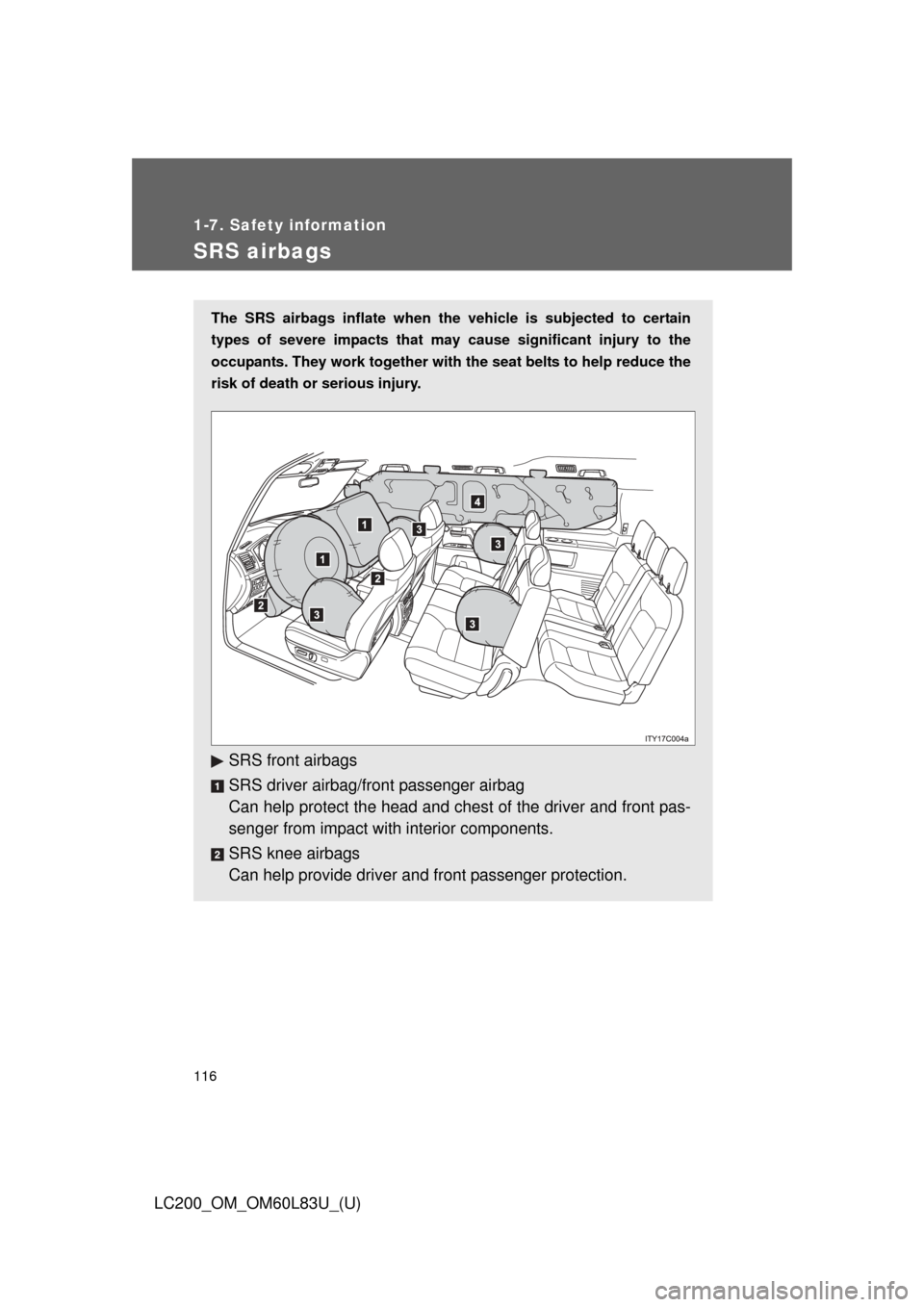
116
1-7. Safety information
LC200_OM_OM60L83U_(U)
SRS airbags
The SRS airbags inflate when the vehicle is subjected to certain
types of severe impacts that may cause significant injury to the
occupants. They work together with the seat belts to help reduce the
risk of death or serious injury.
SRS front airbags
SRS driver airbag/front passenger airbag
Can help protect the head and ches t of the driver and front pas-
senger from impact with interior components.
SRS knee airbags
Can help provide driver and front passenger protection.
Page 117 of 728
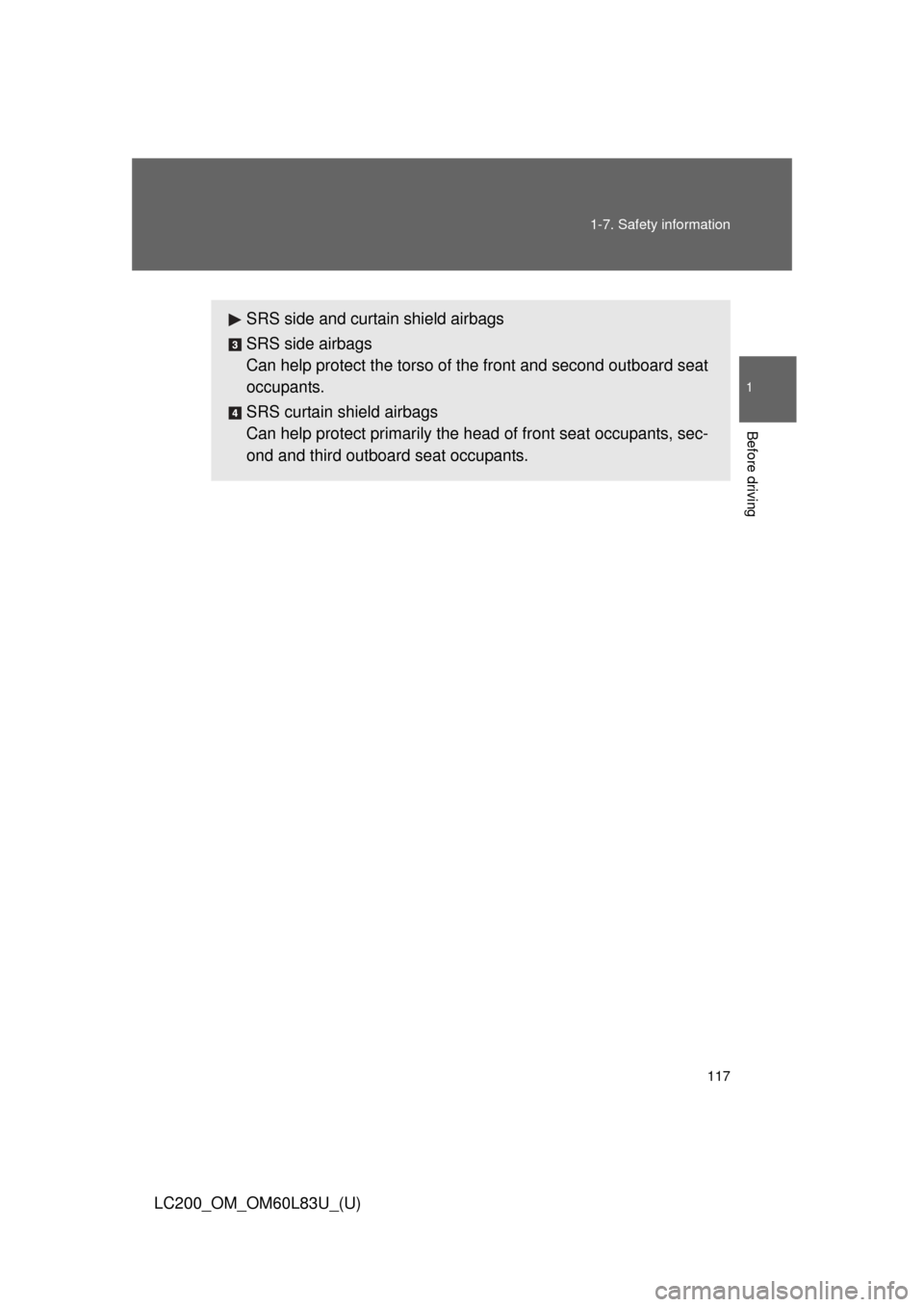
117
1-7. Safety information
1
Before driving
LC200_OM_OM60L83U_(U)
SRS side and curtain shield airbags
SRS side airbags
Can help protect the torso of the front and second outboard seat
occupants.
SRS curtain shield airbags
Can help protect primarily the head of front seat occupants, sec-
ond and third outboard seat occupants.
Page 118 of 728
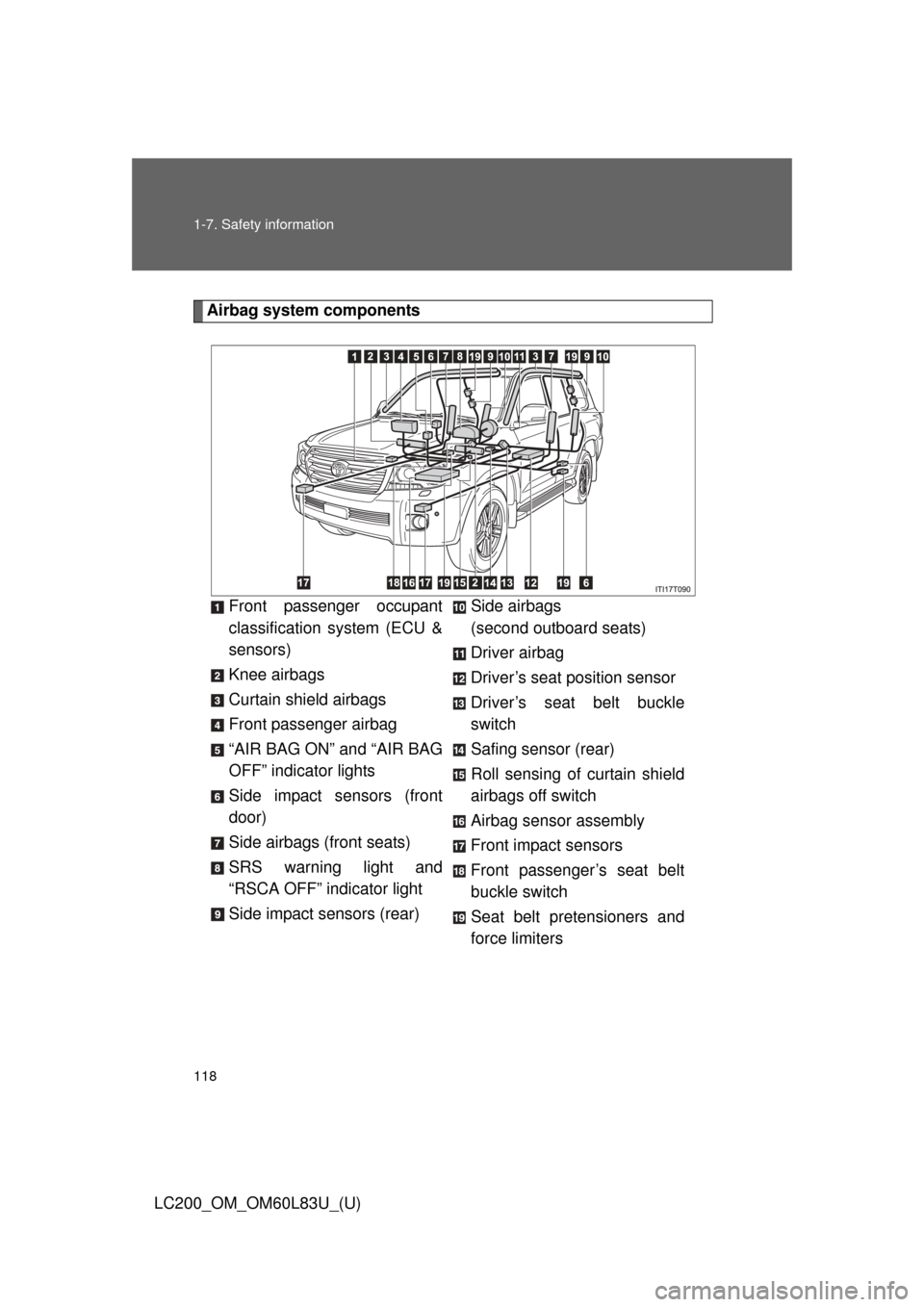
118 1-7. Safety information
LC200_OM_OM60L83U_(U)
Airbag system componentsFront passenger occupant
classification system (ECU &
sensors)
Knee airbags
Curtain shield airbags
Front passenger airbag
“AIR BAG ON” and “AIR BAG
OFF” indicator lights
Side impact sensors (front
door)
Side airbags (front seats)
SRS warning light and
“RSCA OFF” indicator light
Side impact sensors (rear) Side airbags
(second outboard seats)
Driver airbag
Driver’s seat position sensor
Driver’s seat belt buckle
switch
Safing sensor (rear)
Roll sensing of curtain shield
airbags off switch
Airbag sensor assembly
Front impact sensors
Front passenger’s seat belt
buckle switch
Seat belt pretensioners and
force limiters
Page 119 of 728

119
1-7. Safety information
1
Before driving
LC200_OM_OM60L83U_(U)
Your vehicle is equipped with
ADVANCED AIRBAGS designed based
on the US motor vehicle safety standards (FMVSS208). The airbag
sensor assembly (ECU) controls ai rbag deployment based on infor-
mation obtained from the sensors etc. shown in the system compo-
nents diagram above. This inform ation includes crash severity and
occupant information. As the air bags deploy, a chemical reaction in
the inflators quickly fills the airbags with nontoxic gas to help restrain
the motion of the occupants.
■ If the SRS airbags deploy (inflate)
●Bruising and slight abrasions may result from contact with a deploying
(inflating) SRS airbag.
● A loud noise and white powder will be emitted.
● Parts of the airbag module (steering wheel hub, airbag cover and inflator)
as well as the front seats, second seats, and parts of the front, side and
rear pillars, and roof side rail, may be hot for several minutes. The airbag
itself may also be hot.
● The windshield may crack.
● For Safety Connect subscribers, if the SRS airbags deploy or in the event
of a severe rear-end collision, the system is designed to send an emer-
gency call to the response center, notifying them of the vehicle’s location
(without needing to push the “SOS” button) and an agent will attempt to
speak with the occupants to ascertain the level of emergency and assis-
tance required. If the occupants are unable to communicate, the agent
automatically treats the call as an emergency and helps to dispatch the
necessary emergency services. ( P. 508)
Page 120 of 728

120 1-7. Safety information
LC200_OM_OM60L83U_(U)
■SRS airbag deployment conditions (SRS front airbags)
●The SRS front airbag will deploy in the event of an impact that exceeds
the set threshold level (the level of force corresponding to an approxi-
mately 12 - 18 mph [20 - 30 km/h] frontal collision with a fixed wall that
does not move or deform).
However, this threshold velocity will be considerably higher in the following
situations:
• If the vehicle strikes an object, such as a parked vehicle or sign pole,
which can move or deform on impact
• If the vehicle is involved in an underride collision, such as a collision in which the front of the vehicle “underrides”, or goes under, the bed of a
truck
● Depending on the type of collision, it is possible that only the seat belt
pretensioners will activate.
● The SRS front airbags for the front passenger will not activate if there is
no passenger sitting in the front passenger seat. However, the front air-
bags for the front passenger may deploy if luggage is put in the seat,
even if the seat is unoccupied.
■ SRS airbag deployment conditions (SRS side airbags and SRS curtain
shield airbags)
● The SRS side airbags and SRS curtain shield airbags will deploy in the
event of an impact that exceeds the set threshold level (the level of force
corresponding to the impact force produced by an approximately 3300 lb.
[1500 kg] vehicle colliding with the vehicle cabin from a direction perpen-
dicular to the vehicle orientation at an approximate speed of 12 - 18 mph
[20 - 30 km/h]).
● The SRS curtain shield airbags will deploy in the event of vehicle rollover.